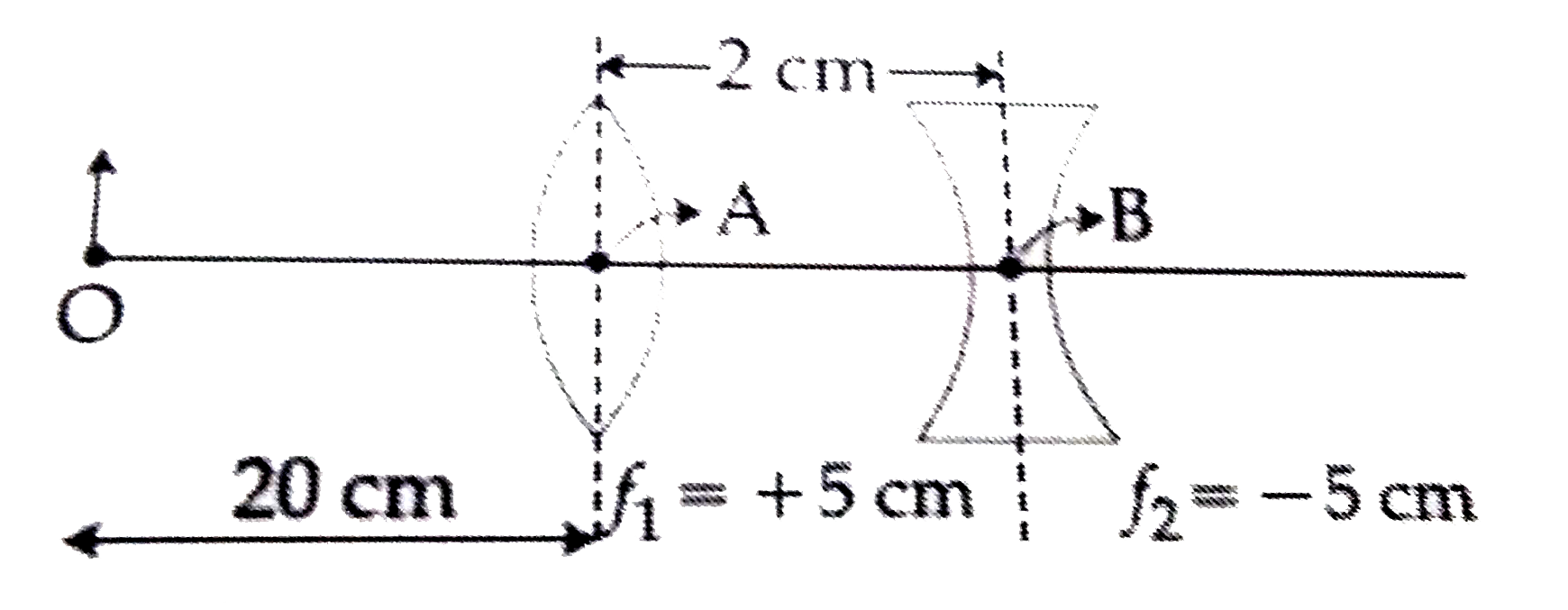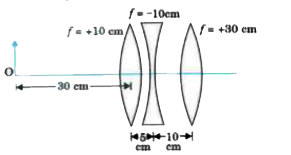what is the position and nature of image formed by lens combination shown in figure ? (f1,f2 are focal lengths)

70cm from point B at left, virtual
70 cm from point B at right, real
40 cm from point B at right, real
203 cm from point B at right, real
The correct Answer is:B
For first lens
1V+120=15⇒1V=15−120=4−120⇒V1=203
distance of first image from B=203−2=142 cm
For second lens
1V−314=−15⇒15−1470=170
70 cm from point B at right , real
Similar Questions
Knowledge Check

If the bio-convex lens is cut as shown in the figure, the new focal length f' isA2fBfC(f)/(2)DInfiniteA convex lens of focal length 30 cm , a concave lens of focal length 120 cm , and a plane mirror are arranged as shown . For an object kept at a distance of 60 cm from the convex lens, the final image, formed by the combination , is a real image , at a distance of :
_E01_195_Q01.png)
|Focal length|=|Focal length|
= 30cm =120cm
_S01_267_Q02.png) A70 cm from the convex lensB60 cm from the convex lensC60 cm from the concave lensD70 cm from the concave lens
A70 cm from the convex lensB60 cm from the convex lensC60 cm from the concave lensD70 cm from the concave lensShown an object and its image formed by a thin lens. Then the nature and focal length of lens is
 Af=4.8cm converging lensBf=−4.8cm diverging lensCf=2.18cm converging lensDf=−2.18cm diverging lens
Af=4.8cm converging lensBf=−4.8cm diverging lensCf=2.18cm converging lensDf=−2.18cm diverging lens
(a) Using the ray diagram for a system of two lenses of focal lengths f1andf2 in contact with each other, show that the two lens system can be regarded as equivalent to a single lens of focal length f, where
1f=1f1+1f2
Also write the relation for the equivalent power of the lens combination.
(b) Determine the position of the image formed by the lens combination given in the figure.

View SolutionA thin double convex lens of focal length f is broken into two equal halves at the axis. The two halves are combined as shown in figure. What is the focal length of combination in (ii) and (iii).

View SolutionTwo lens of power +15Dand−5D are in contact with each other. What is the focal length of the combination ? What would be the position of image formed by the combination for an object at 30cm ?
View Solution(a) An object is placed at the centre of curvature (c ) of a concave mirror. Draw the ray diagram to depict the position, size and nature of image formed.
(b) Find the focal length of a lens of power - 2.0 D. What type of lens is this ?
View SolutionDraw ray diagrams to represent the nature, position and relative size of the lens for the object placed:
a) at 2F1,
b) between F1 and the optical center O of the lens.
Which of the above two cases shows the use of convex lens as a magnifying glass? Give reasons for your choice.
View Solution

